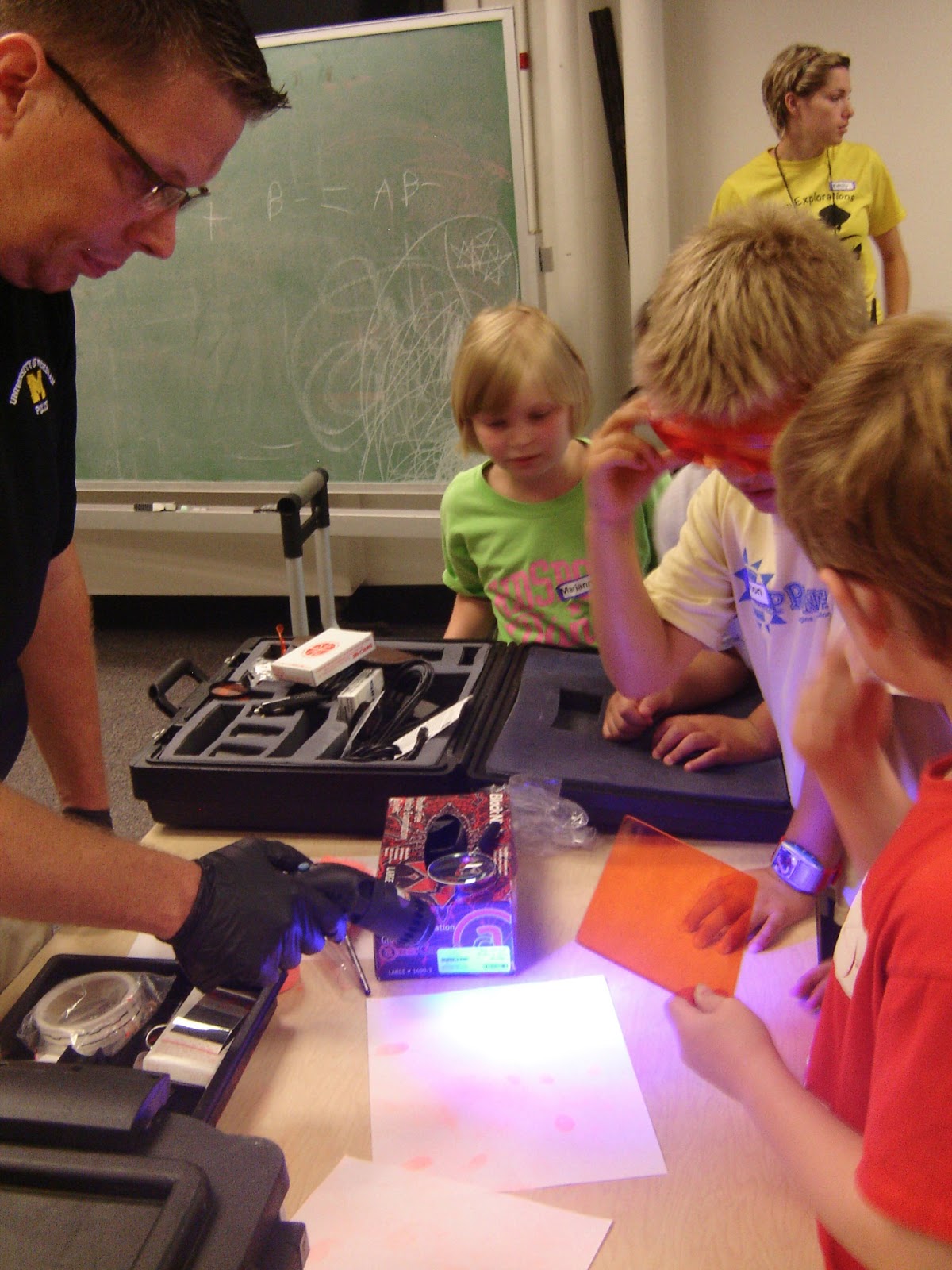We had another crime-solving week of forensic science camp at Camp Explorations! We started out the week with some crime scene basics. We learned how to evaluate a crime scene, and document and collect the evidence. The most exciting part of the day was a visit from a U of M Crime Scene Investigator, who showed us all of the cool tools he uses at crime scenes! He showed us how they collect fingerprints using fluorescent powder and a UV light, how they collect blood samples, and what kind of gear investigators need to wear so they don't leave a trace! We even got to sit inside of his car, which was equipped with all sorts of tools and instruments, and even a siren!
 |
| Drawing a carefully measured diagram of Monday's crime scene |
 |
| Trying on the footies that investigators wear at crime scenes so as to not leave their footprints! |
 |
| Police Officer Tom showing us how to see fingerprints using fluorescent powder and a UV light! |
 |
| Getting to peek into the investigator vehicle and all the cool tools they keep in there. |


On Tuesday, we talked about observation and evidence. We looked at two types of physical evidence that are analyzed simply by observing, not by running tests. First, we looked at the tire tracks of 7 cars and had to match them with tire tracks already given to us. We had to carefully analyze the tire tread and distinct patterns of each tire so that we could accurately make a match! Then we did some forensic entomology! We talked about 4 different types of flies that are analyzed at crime scenes. These flies are attracted to dead bodies, and investigators study the life cycles of these insects to determine how long a body has been dead and what some of the circumstance were surrounding it. We looked specifically at the blow fly. We also talked about how the climate conditions where the body is found can affect the life cycle and type of insect present at the scene. Then we applied this knowledge to several investigations, and measured and collected simulated maggots surrounding the taped outlines of bodies of different "dead" animals to determine how long they had been dead for.
 |
| Comparing tire tracks |
 |
| Talking about how we can use insects to help us solve this mystery |
Wednesday was about wildlife forensics. We took a tour of the 3rd floor of the Museum, which features Michigan wildlife exhibits, and talked about how the animals use their various features, like teeth and claws. Then we looked at a life-size diagram of overlapping footprints, and studied the patterns and layering of them to determine what happened at that scene. Then we looked at antlers and horns and took measurements. We studied how each horn and antler is unique and used our forensic skills to make conclusions about the animal based on their headgear.
 |
| Figuring out what happened at this scene of many animal tracks |
 |
| Measuring and talking about the use of antlers and horns |
On Thursday, we studied hairs and fibers. We talked about how investigators study hair and fibers from clothes or other garments found at crime scenes to help determine a criminal. We looked at many samples of hair under microscopes and saw how the structure of hair and fibers can be different depending on the appearance or texture. Then we made models of hair strands to help us understand the structure of hair. We talked about the cortex, medulla and cuticle, and how these help determine the appearance of hair.
 |
| Talking about fibers before starting out activity |
 |
| Looking at different fibers under the stereoscope |
 |
| Drawing the fibers in our journals |
 |
| Getting a close up view: Looking at animal vs. human hair under a microscope! |
 |
| A great drawing of the enlarged fibers! |
 |
| A completed hair strand model! |
Friday was a great day of excitement! We needed the help of our campers to solve a mysterious situation that happened at the museum Thursday night. We used the tools we had gained throughout the week, as well as some new but helpful ones, to evaluate the evidence and use it to find the criminal!
 |
| Collecting and documenting evidence at the scene of the crime |
 |
| The crime scene |
 |
| Collecting and analyzing the fingerprints from the evidence at the crime scene. |

 |
| Looking at fingerprints under a stereoscope to find any patterns or identification points |
 |
| Doing a pH test to determine if there was anything suspicious in the beverages we found at the crime scene. |
The campers helped us to make an accurate verdict as to who the criminal was, and they got to use their skills learns from the week! The Ann Arbor Police were very thankful that we have such intelligent campers who helped them solve such a mysterious crime. We are looking forward to our next two weeks of camp, which will be archaeology themed. We hope to see some new and many old faces!!






































No comments:
Post a Comment